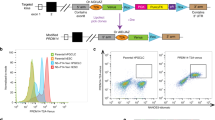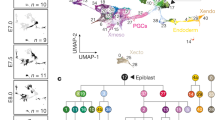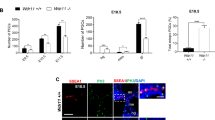Abstract
microRNAs (miRNAs) function as genetic rheostats to control gene output. Based on their role as modulators, it has been postulated that miRNAs canalize development and provide genetic robustness. Here, we uncover a previously unidentified regulatory layer of chemokine signaling by miRNAs that confers genetic robustness on primordial germ cell (PGC) migration. In zebrafish, PGCs are guided to the gonad by the ligand Sdf1a, which is regulated by the sequestration receptor Cxcr7b. We find that miR-430 regulates sdf1a and cxcr7 mRNAs. Using target protectors, we demonstrate that miR-430–mediated regulation of endogenous sdf1a (also known as cxcl12a) and cxcr7b (i) facilitates dynamic expression of sdf1a by clearing its mRNA from previous expression domains, (ii) modulates the levels of the decoy receptor Cxcr7b to avoid excessive depletion of Sdf1a and (iii) buffers against variation in gene dosage of chemokine signaling components to ensure accurate PGC migration. Our results indicate that losing miRNA-mediated regulation can expose otherwise buffered genetic lesions leading to developmental defects.
This is a preview of subscription content, access via your institution
Access options
Subscribe to this journal
Receive 12 print issues and online access
$209.00 per year
only $17.42 per issue
Buy this article
- Purchase on Springer Link
- Instant access to full article PDF
Prices may be subject to local taxes which are calculated during checkout







Similar content being viewed by others
References
Kitano, H. Biological robustness. Nat. Rev. Genet. 5, 826–837 (2004).
Maheshri, N. & O'Shea, E.K. Living with noisy genes: how cells function reliably with inherent variability in gene expression. Annu. Rev. Biophys. Biomol. Struct. 36, 413–434 (2007).
Hornstein, E. & Shomron, N. Canalization of development by microRNAs. Nat. Genet. 38 Suppl, S20–S24 (2006).
Raser, J.M. & O'Shea, E.K. Noise in gene expression: origins, consequences, and control. Science 309, 2010–2013 (2005).
Raj, A. & van Oudenaarden, A. Nature, nurture, or chance: stochastic gene expression and its consequences. Cell 135, 216–226 (2008).
Herranz, H. & Cohen, S.M. MicroRNAs and gene regulatory networks: managing the impact of noise in biological systems. Genes Dev. 24, 1339–1344 (2010).
Sangster, T.A. et al. HSP90 affects the expression of genetic variation and developmental stability in quantitative traits. Proc. Natl. Acad. Sci. USA 105, 2963–2968 (2008).
Rutherford, S.L. & Lindquist, S. Hsp90 as a capacitor for morphological evolution. Nature 396, 336–342 (1998).
Bartel, D.P. MicroRNAs: target recognition and regulatory functions. Cell 136, 215–233 (2009).
Stark, A., Brennecke, J., Bushati, N., Russell, R.B. & Cohen, S.M. Animal MicroRNAs confer robustness to gene expression and have a significant impact on 3′UTR evolution. Cell 123, 1133–1146 (2005).
Bartel, D.P. & Chen, C.Z. Micromanagers of gene expression: the potentially widespread influence of metazoan microRNAs. Nat. Rev. Genet. 5, 396–400 (2004).
Wu, C.I., Shen, Y. & Tang, T. Evolution under canalization and the dual roles of microRNAs: a hypothesis. Genome Res. 19, 734–743 (2009).
Li, X., Cassidy, J.J., Reinke, C.A., Fischboeck, S. & Carthew, R.W. A microRNA imparts robustness against environmental fluctuation during development. Cell 137, 273–282 (2009).
Raz, E. Primordial germ-cell development: the zebrafish perspective. Nat. Rev. Genet. 4, 690–700 (2003).
Raz, E. & Mahabaleshwar, H. Chemokine signaling in embryonic cell migration: a fisheye view. Development 136, 1223–1229 (2009).
Naumann, U. et al. CXCR7 functions as a scavenger for CXCL12 and CXCL11. PLoS ONE 5, e9175 (2010).
Boldajipour, B. et al. Control of chemokine-guided cell migration by ligand sequestration. Cell 132, 463–473 (2008).
Giraldez, A.J. et al. MicroRNAs regulate brain morphogenesis in zebrafish. Science 308, 833–838 (2005).
Giraldez, A.J. et al. Zebrafish MiR-430 promotes deadenylation and clearance of maternal mRNAs. Science 312, 75–79 (2006).
Nakahara, K. et al. Targets of microRNA regulation in the Drosophila oocyte proteome. Proc. Natl. Acad. Sci. USA 102, 12023–12028 (2005).
Choi, W.Y., Giraldez, A.J. & Schier, A.F. Target protectors reveal dampening and balancing of nodal agonist and antagonist by miR-430. Science 318, 271–274 (2007).
Doitsidou, M. et al. Guidance of primordial germ cell migration by the chemokine SDF-1. Cell 111, 647–659 (2002).
Weidinger, G. et al. Regulation of zebrafish primordial germ cell migration by attraction towards an intermediate target. Development 129, 25–36 (2002).
Busch-Nentwich, E. et al. Sanger Institute Zebrafish Mutation Resource targeted knock-out mutants phenotype and image data submission. ZFIN Direct Data Submission (2010).
Knaut, H., Werz, C., Geisler, R. & Nusslein-Volhard, C. A zebrafish homologue of the chemokine receptor Cxcr4 is a germ-cell guidance receptor. Nature 421, 279–282 (2003).
Mangan, S. & Alon, U. Structure and function of the feed-forward loop network motif. Proc. Natl. Acad. Sci. USA 100, 11980–11985 (2003).
Wall, M.E., Dunlop, M.J. & Hlavacek, W.S. Multiple functions of a feed-forward-loop gene circuit. J. Mol. Biol. 349, 501–514 (2005).
Alon, U. Network motifs: theory and experimental approaches. Nat. Rev. Genet. 8, 450–461 (2007).
Knaut, H., Blader, P., Strähle, U. & Schier, A.F. Assembly of trigeminal sensory ganglia by chemokine signaling. Neuron 47, 653–666 (2005).
David, N.B. et al. Molecular basis of cell migration in the fish lateral line: role of the chemokine receptor CXCR4 and of its ligand, SDF1. Proc. Natl. Acad. Sci. USA 99, 16297–16302 (2002).
Siekmann, A.F., Standley, C., Fogarty, K.E., Wolfe, S.A. & Lawson, N.D. Chemokine signaling guides regional patterning of the first embryonic artery. Genes Dev. 23, 2272–2277 (2009).
Nair, S. & Schilling, T.F. Chemokine signaling controls endodermal migration during zebrafish gastrulation. Science 322, 89–92 (2008).
Mizoguchi, T., Verkade, H., Heath, J.K., Kuroiwa, A. & Kikuchi, Y. Sdf1/Cxcr4 signaling controls the dorsal migration of endodermal cells during zebrafish gastrulation. Development 135, 2521–2529 (2008).
Luster, A.D. Chemokines–chemotactic cytokines that mediate inflammation. N. Engl. J. Med. 338, 436–445 (1998).
Petit, I., Jin, D. & Rafii, S. The SDF-1-CXCR4 signaling pathway: a molecular hub modulating neo-angiogenesis. Trends Immunol. 28, 299–307 (2007).
Broxmeyer, H.E. et al. Transgenic expression of stromal cell-derived factor-1/CXC chemokine ligand 12 enhances myeloid progenitor cell survival/antiapoptosis in vitro in response to growth factor withdrawal and enhances myelopoiesis in vivo. J. Immunol. 170, 421–429 (2003).
Aiuti, A., Webb, I.J., Bleul, C., Springer, T. & Gutierrez-Ramos, J.C. The chemokine SDF-1 is a chemoattractant for human CD34+ hematopoietic progenitor cells and provides a new mechanism to explain the mobilization of CD34+ progenitors to peripheral blood. J. Exp. Med. 185, 111–120 (1997).
Vandercappellen, J., Van Damme, J. & Struyf, S. The role of CXC chemokines and their receptors in cancer. Cancer Lett. 267, 226–244 (2008).
Müller, A. et al. Involvement of chemokine receptors in breast cancer metastasis. Nature 410, 50–56 (2001).
Svoboda, P. & Flemr, M. The role of miRNAs and endogenous siRNAs in maternal-to-zygotic reprogramming and the establishment of pluripotency. EMBO Rep. 11, 590–597 (2010).
Rosa, A., Spagnoli, F.M. & Brivanlou, A.H. The miR-430/427/302 family controls mesendodermal fate specification via species-specific target selection. Dev. Cell 16, 517–527 (2009).
Varghese, J. & Cohen, S.M. microRNA miR-14 acts to modulate a positive autoregulatory loop controlling steroid hormone signaling in Drosophila. Genes Dev. 21, 2277–2282 (2007).
Li, Y., Wang, F., Lee, J.A. & Gao, F.B. microRNA-9a ensures the precise specification of sensory organ precursors in Drosophila. Genes Dev. 20, 2793–2805 (2006).
Hilgers, V., Bushati, N. & Cohen, S.M. Drosophila microRNAs 263a/b confer robustness during development by protecting nascent sense organs from apoptosis. PLoS Biol. 8, e1000396 (2010).
Zhang, F., Gu, W., Hurles, M.E. & Lupski, J.R. Copy number variation in human health, disease, and evolution. Annu. Rev. Genomics Hum. Genet. 10, 451–481 (2009).
Friedman, R.C., Farh, K.K., Burge, C.B. & Bartel, D.P. Most mammalian mRNAs are conserved targets of microRNAs. Genome Res. 19, 92–105 (2009).
Wienholds, E., Koudijs, M.J., van Eeden, F.J., Cuppen, E. & Plasterk, R.H. The microRNA-producing enzyme Dicer1 is essential for zebrafish development. Nat. Genet. 35, 217–218 (2003).
Boldajipour, B., Mahabaleshwar, H. & Kardash, E. Control of chemokine-guided cell migration by ligand sequestration. Cell 132, 463–473 (2008).
Mishima, Y. et al. Zebrafish miR-1 and miR-133 shape muscle gene expression and regulate sarcomeric actin organization. Genes Dev. 23, 619–632 (2009).
Acknowledgements
We thank H. Patnode for fish husbandry, C. Takacs and C. Stahlhut for discussion and critical reading of the manuscript, H. Xue for analysis of the Sdf1a 3′ UTR and D. Stemple for cxcr7b mutant zebrafish. This work was supported by the National Research Service Award US National Institutes of Health (NIH)/National Institute of General Medicine Sciences T32 GM007223 Training Grant (A.A.S.), NIH grants R01GM081602-03/03S1, the Yale Scholar program, the Pew Scholars Program in Biomedical Sciences (A.J.G.) and a Whitehead Fellowship Award (H.K.).
Author information
Authors and Affiliations
Contributions
A.A.S. and A.J.G. designed the experiments and interpreted the results. A.A.S. performed all experiments except the genetic interactions in the cxcr7b and cxcr4b mutant backgrounds, which were performed by H.K. A.A.S. wrote the manuscript with input from H.K. and A.J.G.
Corresponding author
Ethics declarations
Competing interests
The authors declare no competing financial interests.
Supplementary information
Supplementary Text and Figures
Supplementary Figures 1–10, Supplementary Table 1 and Supplementary Note (PDF 1932 kb)
Rights and permissions
About this article
Cite this article
Staton, A., Knaut, H. & Giraldez, A. miRNA regulation of Sdf1 chemokine signaling provides genetic robustness to germ cell migration. Nat Genet 43, 204–211 (2011). https://doi.org/10.1038/ng.758
Received:
Accepted:
Published:
Issue Date:
DOI: https://doi.org/10.1038/ng.758
This article is cited by
-
Germline stem cells in human
Signal Transduction and Targeted Therapy (2022)
-
The miR151 and miR5100 Transfected Bone Marrow Stromal Cells Increase Myoblast Fusion in IGFBP2 Dependent Manner
Stem Cell Reviews and Reports (2022)
-
MiR-430 Can Affect the Mesoderm Formation and Metamorphosis of Paralichthys olivaceus by Targeting lefty Gene
Journal of Ocean University of China (2020)
-
Applications of miRNAs in cardiac development, disease progression and regeneration
Stem Cell Research & Therapy (2019)
-
Effects of short-time exposure to atrazine on miRNA expression profiles in the gonad of common carp (Cyprinus carpio)
BMC Genomics (2019)



